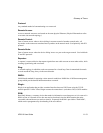Glossary of Terms
11-16
UDS-10 User Guide
Terminal Server:
A concentrator that facilitates communication between hosts and terminals.
Terminator:
Used on both ends of a standard Ethernet or Thinwire Ethernet segment, this special connector
provides the 50 ohm termination resistance needed for the cable.
TFTP:
Trivial File Transfer Protocol. On computers that run the TCP/IP networking software, TFTP is used to
quickly send files across the network with fewer security features than FTP.
Thickwire:
Half-inch diameter coax cable.
Thinwire:
Thin coaxial cable similar to that used for television/video hookups.
Throughput:
The amount of data transmitted between two points in a given amount of time, e.g., 10 Mbps.
Token:
The character sequence or frame, passed in sequence from node to node, to indicate that the node
controlling it has the right to transmit for a given amount of time.
Token Ring:
Developed by IBM, this 4 or 16 Mbps network uses a ring topology and a token-passing access
method.
Topology:
The arrangement of the nodes and connecting hardware that comprises the network. Types include
ring, bus, star and tree.
Transceiver:
The actual device that interfaces between the network and the local node. The term generally refers to
any connector, such as a MAU, that actively converts signals between the network and the local node.
Transceiver Cable:
Cable that attaches a device either to a standard or thin coax Ethernet segment.


















